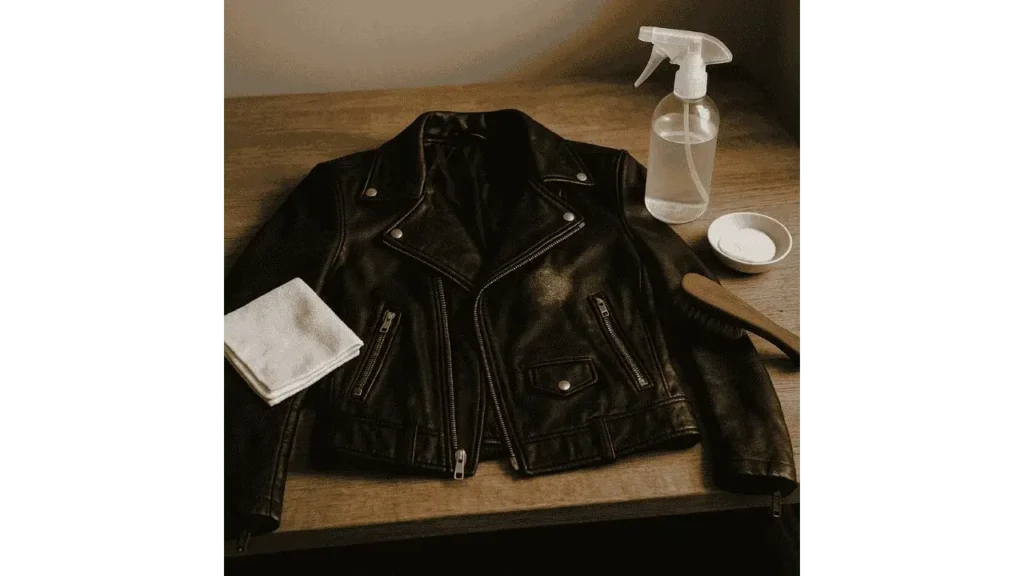Mildew on a leather jacket is not just unsightly, it can also damage the material if left untreated. This fungal growth thrives in damp, poorly ventilated areas, making leather especially vulnerable when stored improperly. Removing mildew safely requires a careful approach to avoid ruining the leather’s texture and finish. This guide provides step-by-step instructions to clean mildew while preserving the quality of your leather jacket.

What to Avoid While Cleaning Mildew from a Leather Jacket?
Cleaning mildew from leather requires the right techniques, as using the wrong methods can worsen the damage. Avoid soaking the leather in water, as excess moisture can lead to further mold growth and weaken the material. Harsh chemicals such as bleach or ammonia should never be used, as they strip the leather of its natural oils, leaving it dry and brittle. Scrubbing aggressively can cause discoloration and cracks, so always use gentle, controlled motions while cleaning.
“Leather is a living material, it needs proper care to resist mold, mildew, and premature aging,” says James Corbin, a professional leather restorer with over 20 years of experience in vintage jacket preservation.
Effective Methods to Follow
The Wipe-Off Method
For light mildew buildup, wiping it off with a dry cloth is the first step. Take the jacket outside to prevent mildew spores from spreading indoors. Use a soft, dry cloth to gently remove the surface mildew. If the mildew is persistent, dampen a clean cloth with a mixture of equal parts white vinegar and water. Gently wipe the affected areas, allowing the solution to break down the mildew without soaking the leather. Let the jacket air dry naturally away from direct sunlight or heat sources.
Read More: How Do I Soften a Leather Jacket?
Using Dish Soap Detergent
For more stubborn mildew stains, a mild dish soap solution works effectively. Mix a few drops of mild dish detergent with lukewarm water and dip a soft cloth into the mixture. Gently clean the mildew-affected areas, ensuring that the leather does not become overly wet. Wipe off any soap residue with a separate damp cloth, then dry the jacket with a clean towel. To restore moisture, apply a leather conditioner once the jacket is fully dry.
“Even a trace of mildew can penetrate the leather fibers if left unchecked. Early intervention is key,” explains Dr. Lila Mendoza, a materials scientist specializing in natural textiles and leather conservation.
Trust the Professionals With Your Leather Jackets
If the mildew has spread extensively or caused noticeable damage, professional leather cleaning is the best option. Leather specialists use advanced techniques to remove mildew without harming the material. This is especially important for high-quality leather jackets or delicate finishes that require extra care. Seeking professional help ensures that the jacket remains in excellent condition without risking further damage through improper cleaning methods.
Final Takeaways
Mildew on a leather jacket should be addressed as soon as possible to prevent long-term damage. Avoid excessive moisture and harsh chemicals, as they can ruin the leather’s texture. Wiping off mildew with a vinegar solution, using a mild dish soap detergent, or seeking professional cleaning are effective ways to restore the jacket. Proper storage in a dry, ventilated area helps prevent mildew from returning. With the right care, a leather jacket remains mildew-free and lasts for years.
- How to Wear an Oversized Leather Jacket? Style Tips for a Casual Look - August 6, 2025
- How to Fold a Leather Jacket? - August 5, 2025
- How Should a Leather Jacket Fit a Woman? - August 1, 2025



